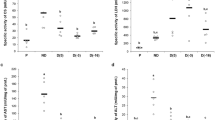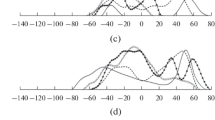Summary
Abrupt temperature change, from 23 to 13 °C, 13 to 3 °C or vice versa, was used to study the metabolic events associated with cryoprotectant polyol synthesis and the reversibility of polyol accumulations in the overwintering, freezing tolerant larvae of the gall fly,Eurosta solidaginis.
Sorbitol synthesis was induced when larvae acclimated to 13 °C were abruptly moved to 3 °C. A precursor-product relationship between glucose-6-P, glucose and sorbitol was apparent with elevated levels of the compounds in the larvae first detected after 1, 2 and 24 h at 3 °C, respectively. A negative cross-over (increase in fructose-6-P, decrease in fructose-1,6-P2 levels) at phosphofructokinase at 3 °C demonstrated that inhibition at this locus was responsible for the diversion of carbon flow into sorbitol synthesis.
Glycerol synthesis was stimulated when larvae acclimated to 23 °C were chilled to 13 °C, with increased glycerol levels first apparent after 2 days at 13 °C. Synthesis was accomplished via an activation of glycogenolysis coupled with a facilitation of flux through the phosphofructokinase locus and an inhibition (negative cross-over) of flux at the pyruvate kinase reaction resulting in a diversion of triose phosphates into the pathway of glycerol synthesis.
Warming of the larvae resulted in a rapid catabolism of sorbitol, with a restoration of glycogen reserves, when larvae were switched from 3 to 13 °C. Glycerol content of the larvae, however, did not respond to warming and remained constant when larvae were moved from 13 to 23 °C.
The two cyoprotectants appear to have different roles in the overwintering larvae. Glycerol, once synthesized, provides a constant and permanent cryoprotection throughout the winter. Accumulation of this polyol also appears to be anticipatory occurring in response to chilling at relatively high temperatures, well above those at which cryoprotection is needed. Sorbitol, however, is produced only in direct response to cold when freezing temperatures are imminent. Sorbitol provides a variable cryoprotection, levels of the polyol responding to increases or decreases in ambient temperature.
Similar content being viewed by others
References
Baust JG, Lee RE (1982) Environmental triggers to cryoprotectant modulation in separate populations of the gall fly,Eurosta solidaginis (Fitch). J Insect Physiol 28:431–436
Bergmeyer HU, Gruber W, Gutman I (1974) D-Sorbitol. In: Bergmeyer HU (ed) Methods of enzymatic analysis. Academic Press, New York, pp 1323–1326
Eggstein M, Kuhlmann E (1974) Triglycerides and glycerol: determination after alkaline hydrolysis. In: Bergmeyer HU (ed) Methods of enzymatic analysis. Academic Press, New York, pp 1825–1831
Gerlach U, Hiby W (1974) Sorbitol dehydrogenase. In: Bergmeyer HU (ed) Methods of enzymatic analysis. Academic Press, New York, pp 569–573
Keppler D, Decker K (1974) Glycogen: determination with amyloglucosidase. In: Bergmeyer HU (ed) Methods of enzymatic analysis. Academic Press, New York, pp 1127–1131
Lowry OH, Passonneau JV (1972) A flexible system of enzymatic analysis. Academic Press, New York, pp 146–218
Morrissey RE, Baust JG (1976) The ontogeny of cold tolerance in the gall fly,Eurosta solidaginis. J Insect Physiol 22: 431–437
Storey KB (1982a) Metabolism and bound water in overwintering insects. Cryobiology (in press)
Storey KB (1982b) Phosphofructokinase from the overwintering gall fly larva,Eurosta solidaginis: Control of cryoprotectant polyol synthesis. Insect Biochem (in press)
Storey KB, Storey JM (1981) Biochemical strategies of overwintering in the gall fly larva,Eurosta solidaginis: Effect of low temperature acclimation on the activities of enzymes of intermediary metabolism. J Comp Physiol 144:191–199
Storey KB, Baust JG, Storey JM (1981) Intermediary metabolism during low temperature acclimation in the overwintering gall fly larva,Eurosta solidaginis J Comp Physiol 144:183–190
Williamson JR (1970) General features of metabolic control as applied to the erythrocyte. Adv Biol Med 6:117–136
Yanagawa H-A (1978) Tissue distribution, purifications and properties of multiple forms of hexokinase in the silkworm,Bombyx mori. Insect Biochem 8:293–305
Ziegler R, Ashida M, Fallon AM, Wimer LT, Wyatt SS, Wyatt GR (1979) Regulation of glycogen phosphorylase in fat body ofCecropia silkmoth pupae. J Comp Physiol 131:321–332
Author information
Authors and Affiliations
Rights and permissions
About this article
Cite this article
Storey, J.M., Storey, K.B. Regulation of cryoprotectant metabolism in the overwintering gall fly larva,Eurosta solidaginis: Temperature control of glycerol and sorbitol levels. J Comp Physiol B 149, 495–502 (1983). https://doi.org/10.1007/BF00690008
Accepted:
Issue Date:
DOI: https://doi.org/10.1007/BF00690008




